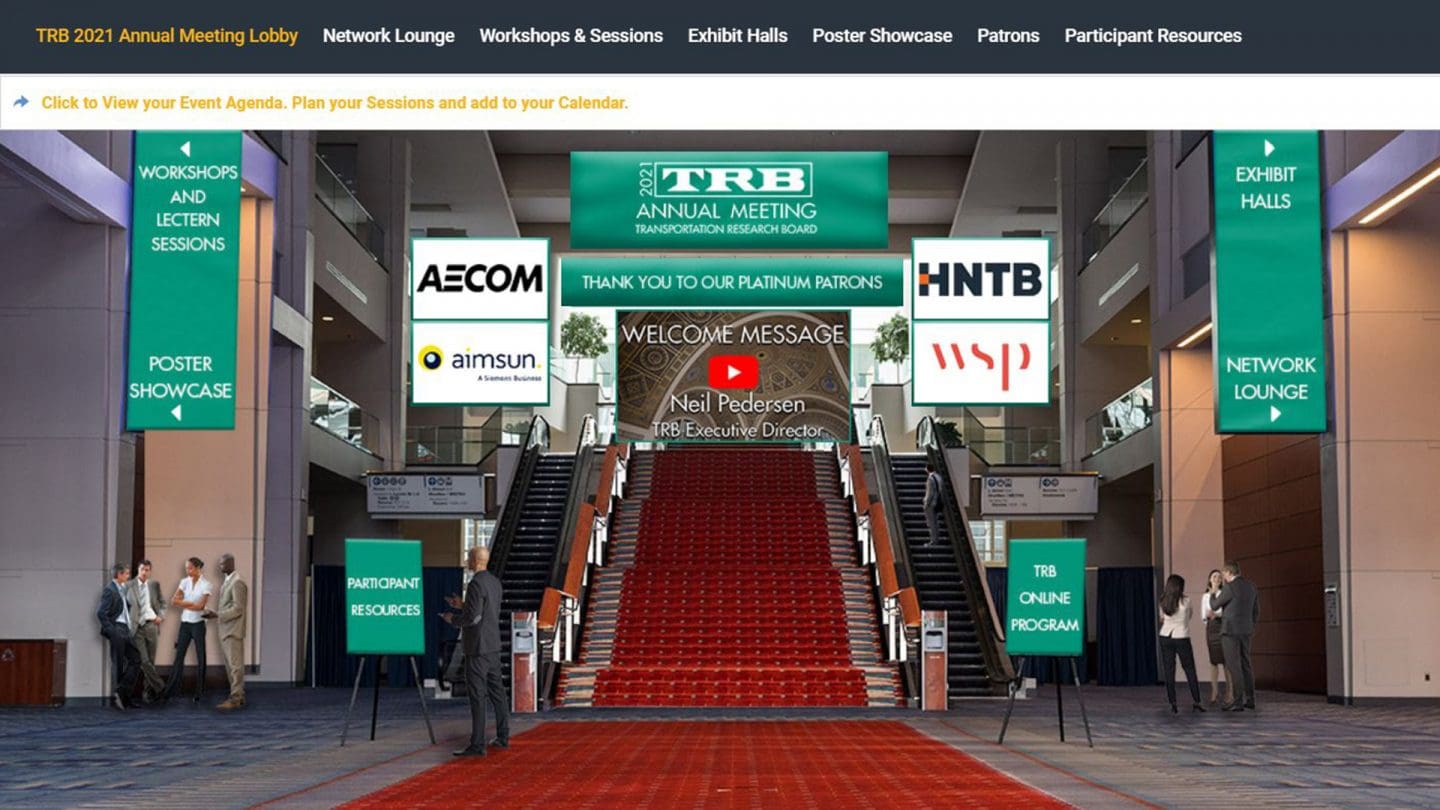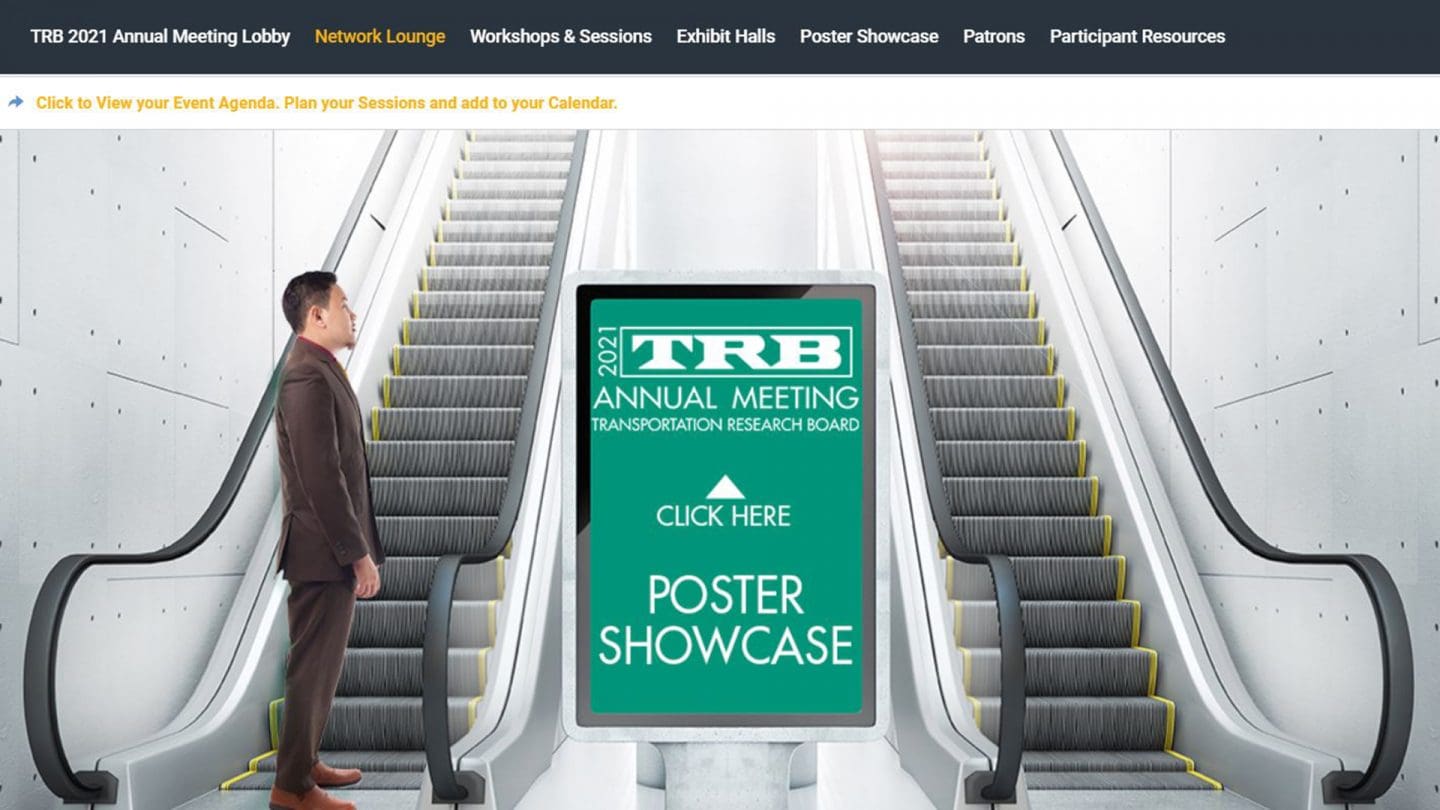February 3, 2021
40 Kittelson team members attended the first-ever virtual iteration of the Transportation Research Board’s Annual Meeting between January 5 and 29, 2021. And we weren’t alone in sending a large cohort: more than 19,000 individuals registered for the event, a nearly 50% increase in registrations over a typical TRB year.
As with countless other events that have changed format due to COVID-19, there were benefits and challenges with taking TRB 2021 virtual. While the barriers to entry for TRB 2021 were lower than usual-no flight to Washington DC, no hotel rooms, and no week off other work responsibilities were needed-a virtual conference that large can’t avoid technical difficulties along the way.
Still, we were grateful to still have a way to connect with fellow transportation researchers and swap insights, questions, and examples. Hermanus Steyn, senior principal engineer in Kittelson’s Portland office, noted it was a feat to pull off the event at all.
“They’ve done an amazing job. To organize a 19,000 person conference virtually, that’s not a small task. I know we all had a few challenges along the way, but we still had TRB, and that’s very sweet.”
“They did a good job with the website and portal to make it feel like you were actually there,” said Spencer Maddox, transportation analyst in our Miami office, who attended TRB for the first time in 2021. “It was easy to know what was happening and when. If you missed a session, it was archived so you could watch later. So other than a technical learning curve with presenting poster sessions, it was easy as a first-timer to get oriented.”


4 Themes From The TRB 2021 Annual Meeting
The TRB has always been about sharing ideas and connecting on the biggest challenges and research questions facing our communities today, and the 2021 Annual Meeting was no different. From the sessions Kittelson staff attended, here are four major themes that stood out to us.
Changing Travel Patterns: Where Do We Go From Here?
Naturally, the theme of changing patterns due to COVID-19 sprung up everywhere. Much of the dialogue was focused around transit planning and transit resiliency in light of the pandemic and the massive shift to working from home.
Mary Raulerson, senior principal planner in Kittelson’s Orlando office, noted there was a strong emphasis of sharing stories from 2020 and looks forward to taking these conversations to the next level and looking to the future.
“Most of the discussions were focused on: ‘how did you regroup and deal with the last year?'” she said. “Now it’s time to take the unknowns of the last year and ask, ‘how do we think about our transportation systems moving forward differently than we have in the past?'”
Taking Action for Equity in Transportation
The topic of the Thomas B. Deen Distinguished Lecture on Monday, January 25 represented a thread that ran through many sessions at TRB 2021. Dorval Carter, President of the Chicago Transit Authority, presented “Our Work is Never Done: Examining Equity Impacts in Public Transportation,” which shone an honest light onto the many forms inequity takes in public transportation. He challenged agencies to take advantage of the opportunities in front of us to envision a new, stronger vision for equitable public transit with a focus on the people being served. Following his address, Carter had a discussion with Anthony Foxx, former Secretary of Transportation and current Chief Policy Officer of Lyft, who emphasized that public transportation can and should be part of the solution when it comes to building a society of equity and inclusion.
Kittelson team members noted that the equity theme was naturally woven into many discussions because of the way that COVID-19 has disparately impacted populations, particularly when it comes to public transit and essential workers. It was encouraging to see the widespread recognition of these realities. As with the changing travel patterns topic, the need now is to look to the future and talk about where we go from here.
“One approach to equity and transit planning that I found relevant and interesting was from Julie Timm, CEO of the Greater Richmond Transit Company (GRTC),” said Megan Morrow, transportation analyst in our Boston office who was a second-time TRB attendee. “She talked about the GRTC’s ‘Just Cause’ philosophy, where multimodal partnerships are connected to high-frequency public mass transit to support essential connections between affordable housing, quality employment, food, education, and health care.”
The Relationship Between Transportation and Health
The interconnectedness of transportation and health felt more front and center this year than Annual Meetings past. Many sessions highlighted the health impacts of transportation decisions and the inclusion of health impact assessments (HIAs) in planning studies, indicating a strong interest in the transportation research community to advance an understanding of transportation and health in new ways.
“I attended a session about the social determinants of health in transportation. It had to do with land use and other aspects of planning that aren’t extremely transportation-focused, but matter to the work that we do,” said Megan. “They had a wide range of people presenting, which I thought was insightful.”
Collaboration and Breaking Down Silos in Transportation
Workshop 1033, “Breaking Down Silos to Embrace Life in a Multimodal Performance Based Solution,” highlighted TRB’s goals around collaboration, which drove the restructuring of TRB Committees in 2020. This workshop was all about recognizing the silos that exist in transportation-such as institutional, organizational, planning/design, and operations/safety/design-and enhancing collaboration to understand more perspectives. Hermanus Steyn, cochair of the Standing Committee on Performance Effects of Geometric Design, which sponsored the workshop, sees an opportunity to keep this discussion going.
“I can only imagine the discussions that would have happened after the workshop if it was in person,” Hermanus said. “We live in a time in our industry and our country where the theme of breaking down silos is so important.” He noted the committee is considering making this topic a series, identifying these silos in the industry and workshopping them one at a time at future Annual Meetings.
How Would You Approach Another Virtual TRB?
We don’t yet know whether TRB 2022 will be virtual, in-person, or something in between. If the conference is offered virtually in the future, Kittelson team members said they would approach a few things differently.
“It’s easy to fall into the temptation of taking on a full plate of other work during the week,” said Zach Bugg, senior engineer in Wilmington. “If TRB is offered virtually again, I would be more intentional about attending more sessions and trying to avoid the temptation to multitask or continue on project work.”
Mary said she would re-create as much as possible what happens at person in TRB, given the immense networking and marketing potential that comes with attending the conference. “I actually downloaded a coffee house background and have been using that in video meetings,” she said. “When I attend TRB in person, I have lots of meetings over coffee.”
Hermanus said he would create more separation between TRB and other priorities. “My challenge was getting scheduled for non-TRB meetings right before and after because my calendar looked open,” he noted, recommending that TRB attendees in the future carve out more space for follow-up conversations after TRB events.
Ultimately, we are grateful we had a chance to still have a TRB Annual Meeting this year, and we are looking forward to continuing these important conversations throughout the year. If you attended TRB 2021, we’d love to hear your topical takeaways! You can comment on our LinkedIn post or reach out to any of us directly.
